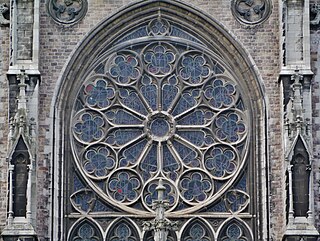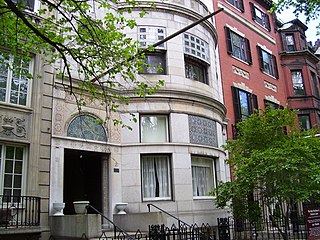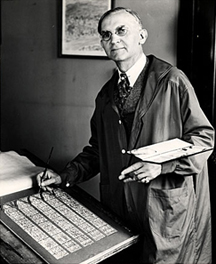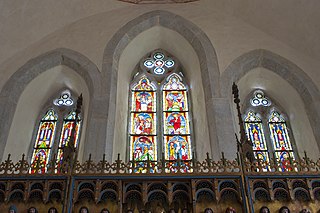
Louis Comfort Tiffany was an American artist and designer who worked in the decorative arts and is best known for his work in stained glass. He is the American artist most associated with the Art Nouveau and Aesthetic movements. He was affiliated with a prestigious collaborative of designers known as the Associated Artists, which included Lockwood de Forest, Candace Wheeler, and Samuel Colman. Tiffany designed stained glass windows and lamps, glass mosaics, blown glass, ceramics, jewellery, enamels, and metalwork. He was the first design director at his family company, Tiffany & Co., founded by his father Charles Lewis Tiffany.

Stained glass is coloured glass as a material or works created from it. Throughout its thousand-year history, the term has been applied almost exclusively to the windows of churches and other significant religious buildings. Although traditionally made in flat panels and used as windows, the creations of modern stained glass artists also include three-dimensional structures and sculpture. Modern vernacular usage has often extended the term "stained glass" to include domestic lead light and objets d'art created from foil glasswork exemplified in the famous lamps of Louis Comfort Tiffany.

John La Farge was an American artist whose career spanned illustration, murals, interior design, painting, and popular books on his Asian travels and other art-related topics.

Sterling Memorial Library (SML) is the main library building of the Yale University Library system in New Haven, Connecticut, United States. Opened in 1931, the library was designed by James Gamble Rogers as the centerpiece of Yale's Gothic Revival campus. The library's tower has sixteen levels of bookstacks containing over 4 million volumes. Several special collections—including the university's Manuscripts & Archives—are also housed in the building. It connects via tunnel to the underground Bass Library, which holds an additional 150,000 volumes.

Old South Church in Boston, Massachusetts, is a historic United Church of Christ congregation first organized in 1669. Its present building was designed in the Gothic Revival style by Charles Amos Cummings and Willard T. Sears, completed in 1873, and amplified by the architects Allen & Collens between 1935–1937. The church, which was built on newly filled land in the Back Bay section of Boston, is located at 645 Boylston Street on Copley Square. It was designated a National Historic Landmark in 1970 for its architectural significance as one of the finest High Victorian Gothic churches in New England. It is home to one of the oldest religious communities in the United States.

Michelin House at 81 Fulham Road, Chelsea, London, was constructed as the first permanent UK headquarters and tyre depot for the Michelin Tyre Company Ltd. The building opened for business on 20 January 1911. In 1987 the building was converted to mixed-use, with a store, restaurant, bar and office space.
The Confederate Memorial State Historic Site is a state-owned property occupying approximately 135 acres (55 ha) near Higginsville, Missouri. From 1891 to 1950, the site was used as an old soldiers' home for veterans of the Confederate States Army after the American Civil War. The Missouri state government then took over operation of the site after the last veteran died in 1950, using it as a state park. In 1981, a cottage, a chapel, and the Confederate cemetery were listed on the National Register of Historic Places as the Confederate Chapel, Cemetery and Cottage. The chapel was moved from its original position in 1913, but was returned in 1978. It has a tower and a stained glass window. The cottage is a small wooden building, and the cemetery contains 723 graves. Within the cemetery is a monument erected by the United Daughters of the Confederacy which is modeled on the Lion of Lucerne. In addition to the cemetery and historic structures, the grounds also contain trails, picnic sites, and fishing ponds.

Clayton and Bell was one of the most prolific and proficient British workshops of stained-glass windows during the latter half of the 19th century and early 20th century. The partners were John Richard Clayton (1827–1913) and Alfred Bell (1832–1895). The company was founded in 1855 and continued until 1993. Their windows are found throughout the United Kingdom, in the United States, Canada, Australia and New Zealand.

The Tiffany and Company Building, also known as the Tiffany Building and 401 Fifth Avenue, is an eight-story commercial building at Fifth Avenue and 37th Street in the Midtown Manhattan neighborhood of New York City. The structure was designed in the Renaissance Revival style by Stanford White of McKim, Mead & White. It was built from 1903 to 1905 as the flagship store of jewelry company Tiffany & Co. The building is a New York City designated landmark and a National Historic Landmark.

The Frederick Ayer Mansion is a National Historic Landmark on 395 Commonwealth Avenue in the Back Bay neighborhood of Boston, Massachusetts.

Christ Church is a historic Episcopal church at 750 Main Street in Waltham, Massachusetts. The church is a parish of the Episcopal Diocese of Massachusetts, and was named to the National Register of Historic Places in 1989.

Charles Jay Connick (1875–1945) was a prominent American painter, muralist, and designer best known for his work in stained glass in the Gothic Revival style. Born in Springboro, Pennsylvania, Connick eventually settled in the Boston area where he opened his studio in 1913. Connick's work is contained in many preeminent churches and chapels, including examples in Boston, Chicago, Detroit, New York City, Pittsburgh, San Francisco, Seattle, and Washington, D.C. He also authored the book Adventures in Light and Color in 1937. Connick's studio continued to operate, and remained a leading producer of stained glass, until 1986.

The Annunciation Cathedral is a Greek Orthodox Cathedral located in Atlanta, Georgia. It is the seat of the Archbishop of the Metropolis of Atlanta, in the Southeastern United States. The church is known for the rich background and extravagant decoration on both the interior and exterior of the church. The original membership of the parish was 72. The current membership includes over 1200 families.

Asia House at No. 82 Princess Street, Manchester, England, is an early 20th century packing and shipping warehouse built between 1906 and 1909 in an Edwardian Baroque style. It is a Grade II* listed building as at 3 October 1974. Nikolaus Pevsner's The Buildings of England describes the warehouse, and its companion, No. 86, Manchester House, as "quite splendid ... good examples of the warehouse type designed for multiple occupation by shipping merchants". It attributes its design to I.R.E. Birkett, architect of the Grade II listed companion building, Manchester House, which is similar in design. English Heritage attributes it to Harry S. Fairhurst. Asia House has an "exceptionally rich" entrance hall and stairwell, "lined with veined marble and green and cream faience, with designs of trees and Art Nouveau stained glass".

Alumnae Hall was the second building to be built on The Western Female Seminary's campus, and was completed in 1892. The building was constructed from funds donated by Olivia Meily Brice, class of 1866, and other alumnae, trustees, and friends of the college. The architecture style of the building was Romanesque Revival. The building remained in use as a library until 1970 when Hoyt Hall opened. Between 1972-1974 it was used as a student center. It was torn down in 1977.

Nicola D'Ascenzo was an Italian-born American stained glass designer, painter and instructor. He is best known for creating stained glass windows for the Washington Memorial Chapel in Valley Forge, Pennsylvania; the Nipper Building in Camden, New Jersey; the Loyola Alumni Chapel of Our Lady at Loyola University Maryland; the Folger Shakespeare Library and Washington National Cathedral, both in Washington, D.C.

Bartlett Gymnasium is a former athletic facility on the campus of the University of Chicago in Chicago, Illinois, United States, that has been converted into a campus dining hall.

First Presbyterian Church is a congregation of the Presbyterian Church (U.S.A) located in downtown Springfield, Illinois. This is the church that President Abraham Lincoln and his family attended while they lived in Springfield.

Art Nouveau glass is fine glass in the Art Nouveau style. Typically the forms are undulating, sinuous and colorful art, usually inspired by natural forms. Pieces are generally larger than drinking glasses, and decorative rather than practical, other than for use as vases and lighting fittings; there is little tableware. Prominently makers, from the 1890s onwards, are in France René Lalique, Emile Gallé and the Daum brothers, the American Louis Comfort Tiffany, Christopher Dresser in Scotland and England, and Friedrich Zitzman, Karl Koepping and Max Ritter von Spaun in Germany. Art Nouveau glass included decorative objects, vases, lamps, and stained glass windows. It was usually made by hand, and was usually colored with metal oxides while in a molten state in a furnace.

The surviving amount of medieval stained glass in Sweden is relatively small, compared to some other European countries. There are in total 165 medieval stained glass panes with figurative depictions surviving in 37 churches, constituting a total area of about 60 square metres (650 sq ft), a fragment of the original amount but still the largest amount found in any of the Nordic countries. Archaeological evidence and old drawings indicate that many more once existed.
























